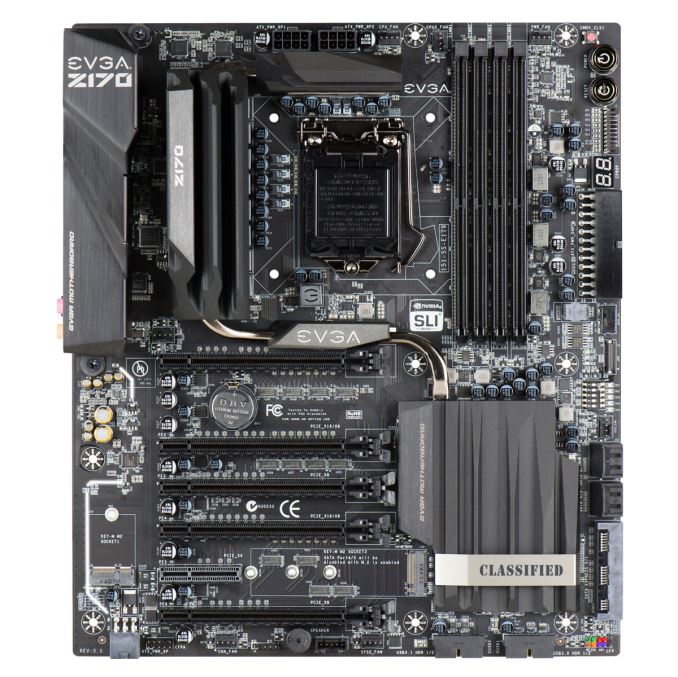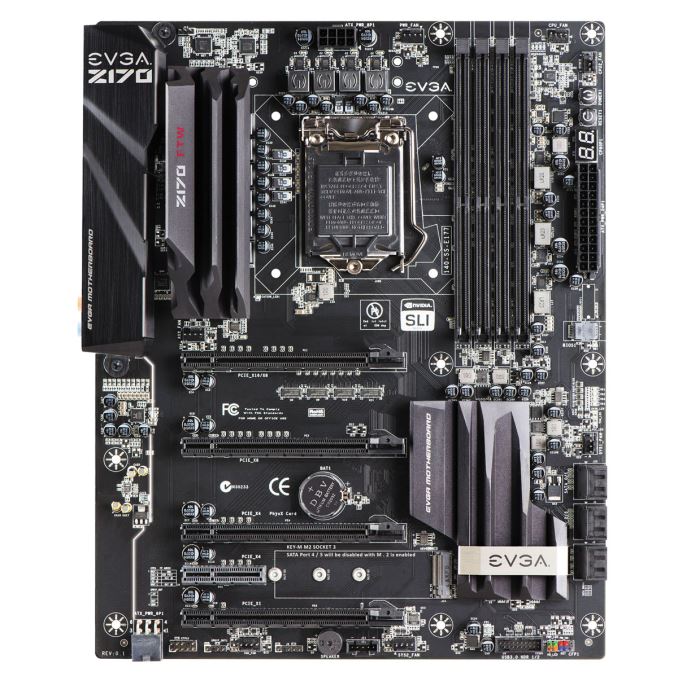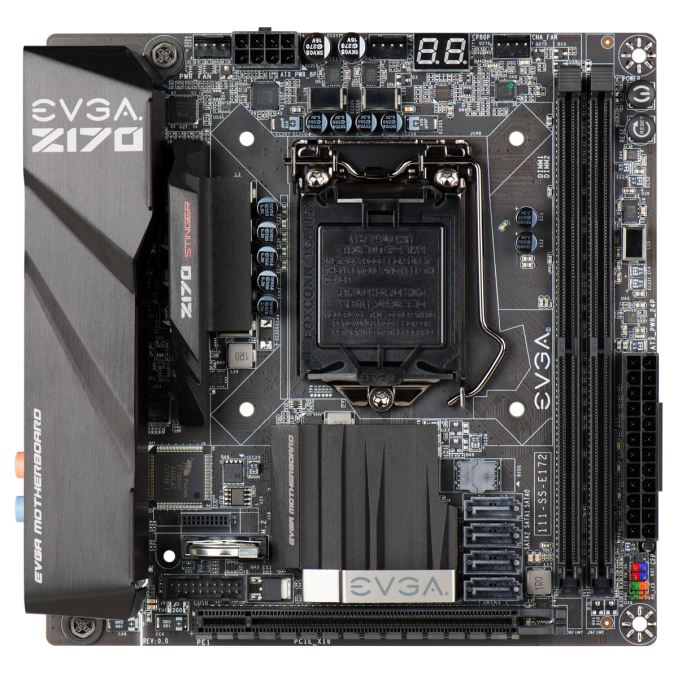Intel Skylake Z170 Motherboards: A Quick Look at 55+ New Products
by Ian Cutress on August 5, 2015 7:59 AM ESTEVGA Z170
Over the past few generations of EVGA motherboards, one of the goals has been to emulate the success they achieved during the X58 motherboard era. At that time, the motherboards were highly praised for their overclocking prowess for what was (and still is) a relatively small motherboard manufacturer. EVGA’s historic strengths lie in their legions of fans and a typical expectation that in most of their big markets, they will field the warranty issues rather than the retailer. Z170, like the others, brings on the EVGA wind in the three regular segments.
EVGA Z170 Classified
Aimed at the pure high end, the EVGA Classified might be the most expensive Z170 board on the market. Here they have used a single PLX 8747 chip under that middle heatsink to provide x8/x8/x8/x8 bandwidth to the PCIe slots. Using a PLX 8747 chip on a mid-range motherboard is not new, it was all the rage back in Z77, but what makes it different here is that the company that manufactures the chip has changed hands and now focuses on the enterprise market. As a result, the costs of such a chip are seemingly doubled overnight, making it an unenticing prospect for the consumer market. Nonetheless, EVGA is aiming for an overclocking motherboard with Quad-SLI support and here it is.
Alongside the extensive heatsink configuration to aid both the power delivery and that PLX chip, EVGA equips the board with dual network controllers (I219-V and I210-AT), a Creative Sound Core3D audio solution, two USB 3.1-A ports on the rear panel, an M.2 slot running in PCIe 3.0 x4 mode, seven 4-pin PWM fan headers, triple BIOS support, EZ voltage read points and the onboard readout will output the temperature when in the operating system.
EVGA Z170 FTW
The FTW follows a similar design pattern to the classified in terms of hardware layout, but reduces it all down into a more cost effective market. As a result the PLX chip is gone, the power delivery heatsink arrangement is reduced, a number of the OC features are lifted off and other connectivity is reduced. The single network port is an Intel I219-V, there is no USB 3.1 and we have the base six SATA ports from the chipset. We still keep the M.2 based off of the PCIe 3.0 x4 bandwidth, but the PCIe slots only support up to x8/x4/x4 with the final slot being an x1. This seems a little odd, given how many PICe lanes the chipset can use.
EVGA Z170 Stinger
The Stinger is the mini-ITX solution, keeping the line alive after several generations. Taking on board previous comments, the power connectors are now on the outside of the DRAM slots or at the top of the motherboard, along with the important front panel connectors. There seems to be enough space around the CPU slot for larger air coolers, although the SATA connector placement will be a nightmare when locking cables and large PCIe cards are used. EVGA does list the Stinger as having a 10-layer PCB, which might make it one of the mini-ITX motherboards with the most layers, although this just makes the design of the board easier and pushes up cost. Similar to the FTW, we don’t get USB 3.1 on this model with only an Intel I219-V network port and Realtek audio.













85 Comments
View All Comments
Norseman4 - Wednesday, August 5, 2015 - link
I'm looking at mITX boards and I saw 3 that are worthwhile (sorry ECS) that has an M.2 port, or a position on the board either stating M.2 or showing the screw positions for it. Only one of them had descriptions about it. (ASUS Z170i Pro Gaming)What of the Gigabyte Z170N-WIFI? The port is on the underside of the board, but I don't know if it's strictly SATA or not.
The EVGA Stinger looks good, but it needs something else before it can be used. Will this be dedicated to a WIFI card like previous versions or can an M.2 drive be used?
Norseman4 - Wednesday, August 5, 2015 - link
Follow up: The EVGA Stinger has a daughter card that converts those pins to M.2 Key E configuration, not B or M that seem to be used for drives.Rauwomos - Thursday, August 6, 2015 - link
Does that mean it has no chance of being used for an M.2 drive then as it is solely an E Keyed M.2 port, is it being converted from a useable key to an e key?Norseman4 - Thursday, August 6, 2015 - link
http://www.evga.com/Products/Product.aspx?pn=111-S...The 20pin socket that's marked M.2 is converted to a M.2 Key E using a daughterboard. I have not seen any drives in the Key E format, so it looks like it's just for something else.
http://www.hwtools.net/PDF/M2%20Adapter%20Selectio...
Norseman4 - Wednesday, August 5, 2015 - link
MSI has information for the Z170i Gaming Pro AC, which lists Turbo M.2. I haven't read what that just yet though. (Source: Tom's Hardware)Norseman4 - Wednesday, August 5, 2015 - link
From an older post about MSI's X99 boards, Turbo M.2 = M.2 Gen 3.0 x4 (All of their Z170 boards have at least 1)Dahak - Wednesday, August 5, 2015 - link
The USB Gen thing was a result of the USB-IF when they release usb 3.1, apple, msi is technically correct as they are following the proper naming.Yes its confusing to regular customers.
Impulses - Wednesday, August 5, 2015 - link
I'm happy with my MSI P67 board but I think I wanna go ASUS this time, that Z170-A looks like a good no nonsense no frills board... And the Z97/X99-A both reviewed pretty well. Kinda light on USB ports but whatever... All I really care for is a decent layout, solid software, and M.2 for an SM951.vLsL2VnDmWjoTByaVLxb - Wednesday, August 5, 2015 - link
"In the previous Z97 chipset, there are a total of 18 Flex-IO ports that can flip between PCIe lanes, USB 3.0 ports or SATA 6 Gbps ports. For Z97, this moves up to 26 and can be used in a variety of configurations:"I think you mean Z170 in that second paragraph.
Ryan Smith - Wednesday, August 5, 2015 - link
Indeed we do. Thanks.